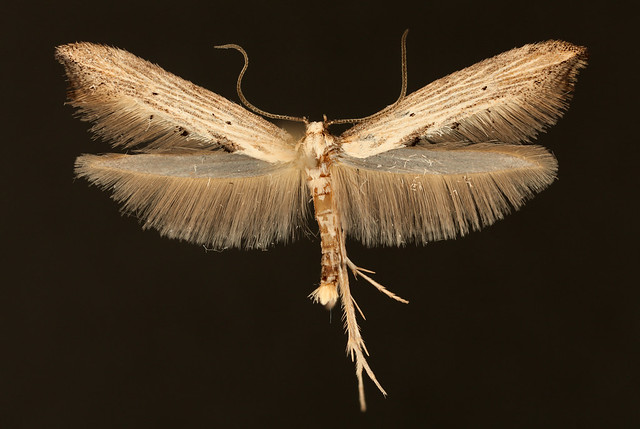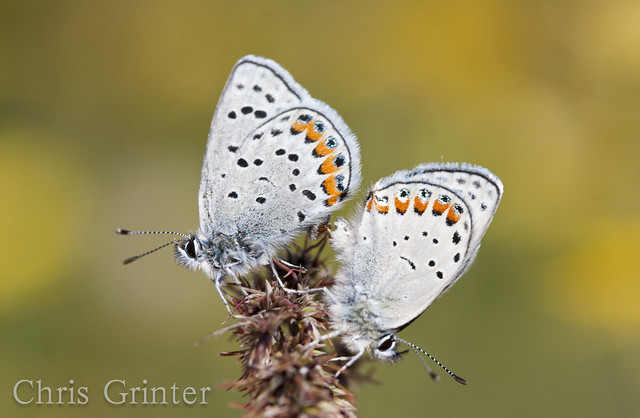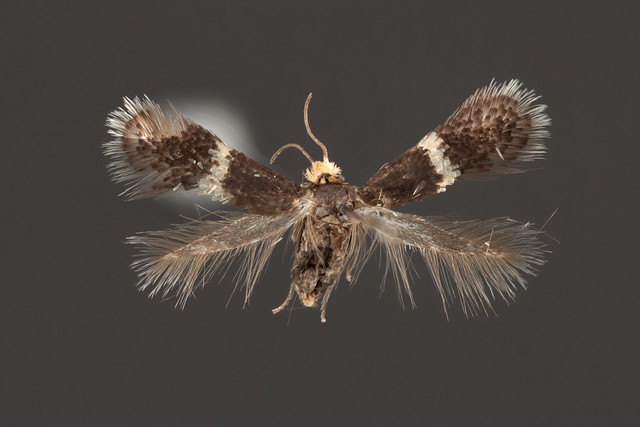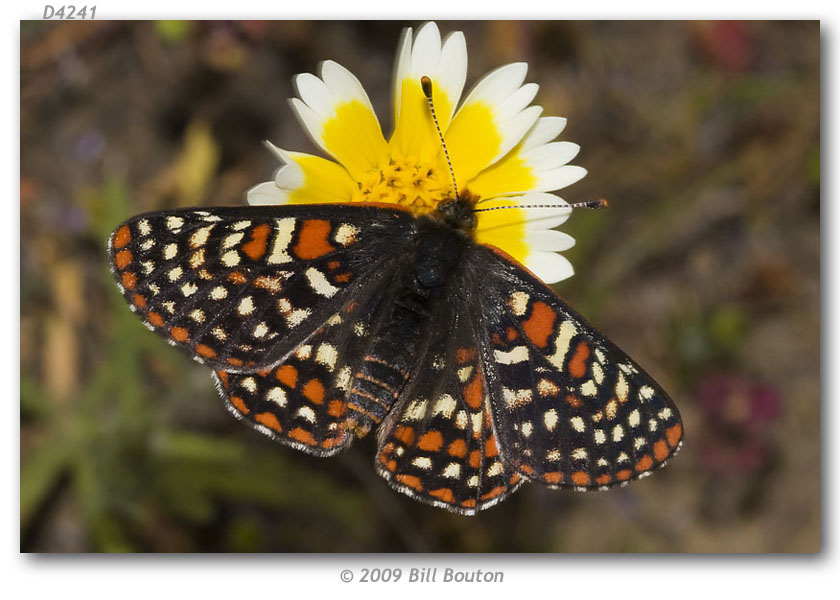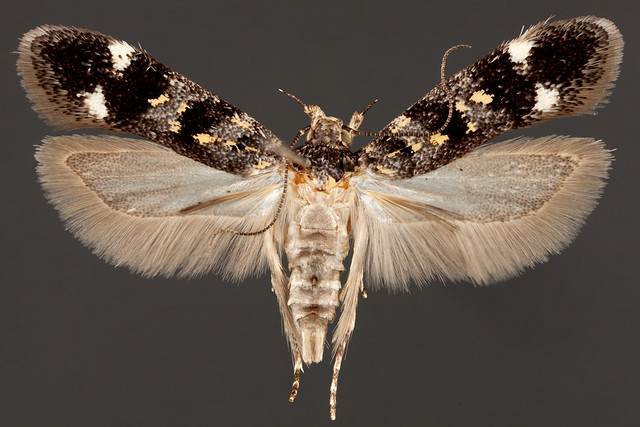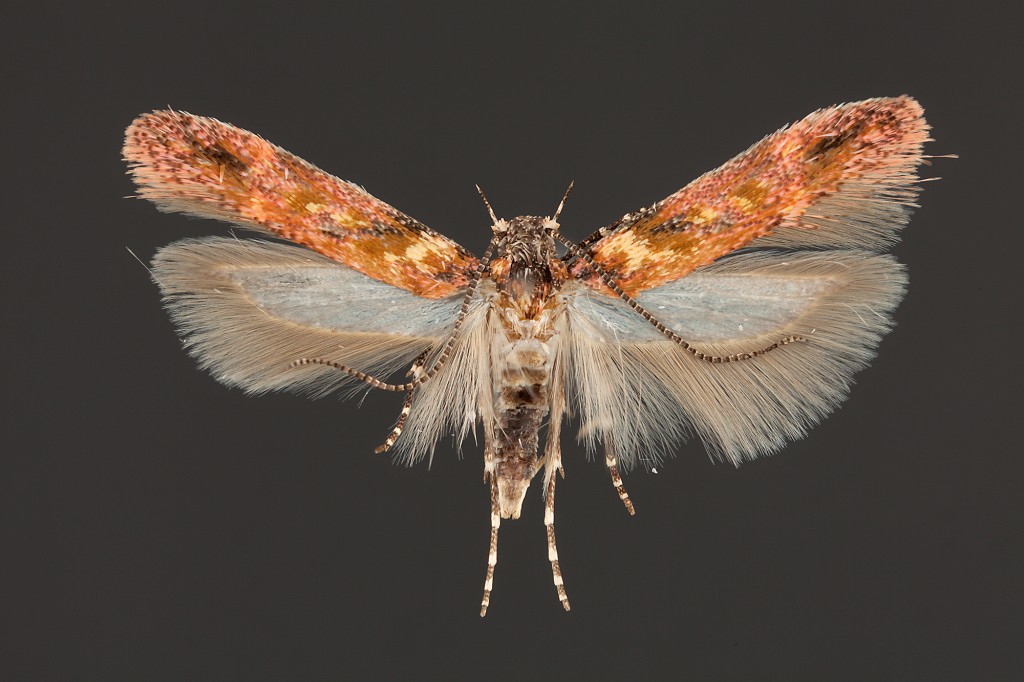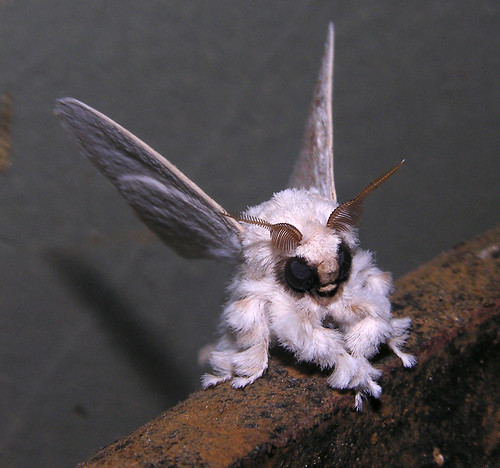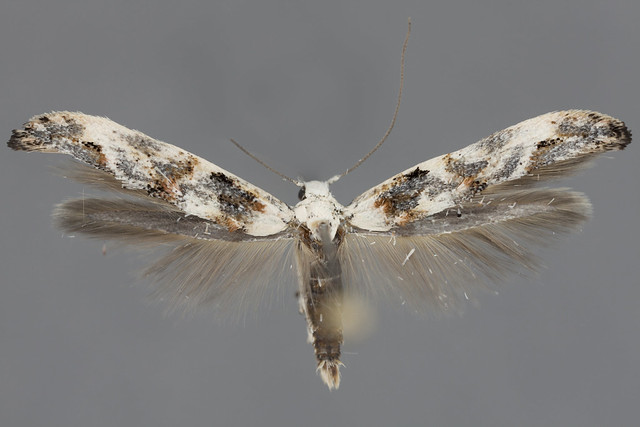Today’s moth is a beautiful species from the Rocky Mountains outside of Denver, Epermenia stolidota (Epermeniidae). This is actually a larger specimen than it appears, about 20mm from wingtip to wingtip. Those raised, darkened, tufts of scales on the posterior edge of the forewing is a great character for this family, as well as the stiff bristles on the hind tibia (also somewhat visible here). Kuna 11 species in 2 genera in the United States, with likely a few more to be discovered. Fellow curatorial assistant David Bettman keyed this species out using the revision of the Nearctic species: PDF here.
|
This week I’m sharing a tiny, scruffy, and semi-competently spread Nepticulidae in the genus Stigmella from the same light trap of Prescott Arizona as the past few Monday Moths. I usually wouldn’t share a photo of a moth that isn’t in the best condition, but I’m using this as an example of technique. Not only was this 4mm moth pulled out of the bottom of a light trap, but it was field pinned and dried for over a year and a half. I’ve always heard that it can nearly be impossible to deal with the smallest of the small; and for the most part I haven’t. I used to think you need to capture them off of a light sheet alive in a vial and euthanize moments before spreading, all while never, ever let them dry the tiniest bit beforehand. But as it turns out, you can get away with a decent specimen by relaxing 24 hours and spreading upside down. Of course if you have a perfectly fresh specimen that avoided the blender of a bucket-trap it would make for a far superior specimen. Better yet, you pulled the leaf mine and reared the moth yourself. Most of these Nepticulidae are host-specific and far more diverse than we have given them credit. I’ve heard there could be at least 100 new species awaiting discovery in the US alone. hadithi ya wengi San Francisco vipepeo ni vizuri inayojulikana na tamaa. eneo amekuwa akishiriki wanashikiliwa na maendeleo ya binadamu kwa zaidi ya karne mbili na ni nyumbani kwa umaarufu mfano wa kwanza inayojulikana ya haiko Kaskazini kipepeo, akaonekana Xerces blue. Wakati vipepeo nyingine ni kunyongwa juu ya, or getting help to hang on like the Bluu ya Misheni, some like the Bay Checkerspot have continued to decline despite valiant efforts for reintroduction. Leo, the only known colony of the Bay Checkerspot is within Santa Clara County on a site called Coyote Ridge. It was twenty one years of intensive study of the checkerspot in the 1960’s and 70’s by the famous biologist Paul Ehrlich that provided the impetus for federal listing in 1987. kama ya 1998 the colonies he studied have since gone extinct. Here is an excerpt from a 1980 paper in the Journal of the Lepidopterists’ Jamii “Two California Checkerspot Butterfly Species, One New, One on the Verge of Extinction” (.pdf).
All efforts to relocate this butterfly have failed, and the future of this animal is not looking bright. And so what exactly is this creatures name? Katika 1937 Robert F. Sternitzky described what he thought to be an overlooked San Francisco butterfly “Euphydryas editha var. bayensis“. Those early descriptions of variations and races are roughly equivalent to today’s subspecies – and so the butterfly remained bayensis for decades and became a mascot for conservation. But where was the very first Euphydras editha from and how did the San Francisco bayensis differ? Unfortunately the original description is vague and the collecting locality is simply listed as “California”, as was the unfortunate habit of Boisduval who described the butterfly 1852. But all hope is not lost since the famous French Lepidopterist was having specimens sent to him by the earliest California Lepidopterist, Pierre Joseph Michel Lorquin. An eager gold prospector and butterfly collector, Lorquin traveled California from 1849 kwa 1858 and again in 1869. Every butterfly that was sent back to France was a new species and subsequently described by Boisduval – who of course named one of California’s most beautiful butterflies after Lorquin. Enter Emmel, Emmel and Mattoon in 1994 who were writing the Systematics of Western North American Butterflies. In the process of cleaning up the mess of these early western species they had to designate a Lectotype for E. editha editha since Boisduval never fixed a Holotype in 1852. Essentially he named a new species without designating the taxonomic standard for the group, making future work ambiguous for taxonomists. Thankfully the travels of Lorquin have roughly been documented and we can ascertain that he should have been in San Francisco around 1849. Comparisons of the original specimens to the Bay Checkerspot made for an overwhelming case that it was this butterfly that was sent to France in the 19th century. The result of this finding therefore places the Bay Checkerspot Euphydryas editha bayensis into synonymy with the older name Euphydryas editha editha. The name bayensis effectively dissappeared because it was a re-description of a butterfly that was already known. Euphydryas e. editha as it turns out has been known from coastal California from the bay region down to San Luis Obispo – and so voila, the range of the Bay Checkerspot just exploded. But of course the story isn’t that simple and the butterfly didn’t become magically safe with a name change. Conservation groups and ecologist kicked and screamed and refused to accept the change, even the Xerces Society hasn’t jumped on board with the consensus of taxonomists out of what I can only assume is fear of the appearance that their butterfly is no longer endangered. I’ll emphasize that this doesn’t mean that the populations in the bay are no longer threatened – there is still a need for protecting these biologically significant populations as they are significantly declining. Habitats all throughout the region are facing ongoing and pernicious threats (pdf). All in all the name change is trivial, we can now call the Edith’s Checkerspot the Bay Checkerspot, and still fight to protect this butterfly. I’m unsure of what would be required to amend the federal register, and if it’s at all possible to expand protection of an animal like this without re-petitioning the endangered species act. So perhaps I can understand the failure to embrace the name change since from the outside it looks like their bug is no longer endangered. Kwa upande mwingine, this could bring attention to populations of a butterfly that have been overlooked for decades.
Many thanks to John Pelham for conferring with me over this taxonomic headache.
Vipi kuhusu Gelechiidae yasiyotambulika kutoka eneo moja kama sampuli ya awali (No.. Prescott Arizona). Ninamchoma nondo huyu akiwa kwenye jenasi Chionodes – na inafanana kijuujuu na spishi C. continuella. Shukrani nyingi kuna monograph wa kundi hili (Nondo ya Amerika Kaskazini ya Mexico, fascicle 7.6) na nitaweza kuchambua na kutumaini kufikia kitambulisho bora zaidi. Sehemu za siri za nondo ni miundo ya ajabu ambayo inaweza kutoa wingi wa wahusika kutumika kwa ajili ya utambuzi.. Nitalazimika kuwa na uhakika wa kushiriki picha za jinsi sehemu za siri zinavyoonekana hivi karibuni!
Nondo hii ni mfano mzuri wa nondo zangu nyingi kwa sasa – wasiojulikana! Hakika huyu ni Gelechiidae, unaweza kuona palps kubwa zilizoinuliwa mbele ya kichwa, na makadirio ya umbo la kidole kwenye ncha za mbawa za nyuma. Takriban mojawapo ya familia rahisi zaidi za kutambua microleps. Na kutoka kwa gestalt ya jumla labda hii iko kwenye Gnorimoschemini? Kama kuna mtu anamtambua huyu dogo tafadhali nijulishe, vinginevyo nitashambulia vichapo ili kujaribu kufuatilia jina. Nondo huyu mzuri anatoka milimani nje ya Prescott, THE – Julai 2010. Badala ya kufurahisha, kuna microlepidoptera nyingi ambazo hazitambuliki kwa urahisi. Inawezekana umesikia habari za kutisha kuhusu kuleta mabadiliko katika Jumba la Jumba la kumbukumbu ya Asili huko Chicago. Kwa kifupi, makumbusho ni katika mgogoro wa fedha na mabadiliko makubwa ni kwenda kutekelezwa na rais mpya, Richard Lariviere. Ni uwezekano kuwa hadi nusu ya wafanyakazi wa utafiti (pamoja na wapangaji wapangaji) itaondolewa na idara zote za utafiti zitafutwa “sayansi na elimu”. Pesa zitatumika kisasa maonyesho, wakati wote wakiguna msingi wa kisayansi wa jumba la kumbukumbu. Tafadhali chukua muda kusaini ombi hili na kusikiza wasiwasi wako: Kinga Utafiti katika Jumba la Makumbusho ya Shambamiezi michache iliyopita wengi wenu pengine mashaka katika meme hii – the famous Poodle Moth! Na hakika kwa sehemu kubwa taarifa alikuwa nusu heshima. Ndiyo, ni kweli. Ndiyo, ni nondo. Ndiyo, pengine ni aina katika Lasiocampidae (possibly the genus Artace) kama usahihi alisema kwa Dr. John Rawlins. I expected this to be all well and good, hey there are tons of cute moths out there and it’s about time someone noticed! I didn’t bother to read the article until a colleague forwarded it to me from the “Cosmic Log on nbcnews.com“. What I found was No real harm, but that whole cryptozoology thing gets me riled up. I think its unfortunate that a cryptozoologist nabbed so much publicity and was talked about with a fair amount of credibility. Cryptozoology is sivyo a science, nor will it ever be. When cryptozoology is conducted as a science it’s called biology. Yes there are nuts out there who believe they are conducting real science, following tall tales in circles and building stacks of anecdotal “evidence” that never seem to result in truths. There are real differences between what a scientist and a pseudoscientist does. Say a scientist hears reports of an odd animal living in the deep jungles – they embark on an expedition (after begging for funding) to do the hard work of piecing together local stories and trekking the jungles or diving the oceans to find the specimens. Then they bring those specimens home, dissect every detail, and publish the results in a peer reviewed journal. If no specimens were found then that scientist goes home empty handed and rethinks the possibility of this new mythical creature. Maybe more funding would give them more time in the field… (always the answer, haki?) But the story ends there, without evidence the animal doesn’t exist. This is where cryptozoology departs from real science – they embrace anecdotal tales as fact and never admit defeat. Nessy exists because people kuona him. The explanation can’t possibly be any large array of more plausible options… because the world a cryptozoologist lives in is mythical and fundamentally not real. OK enough ranting, let’s just hope for more adorable moths hitting the news cycle! Leo nondo ni ndogo stunning na kiumbe mwingine kutoka Barb Bartell ya yadi ya nyuma katika Rockies. Kwa ufahamu wangu ni aina ya Nipe (Coleophoridae), pengine claudiella,lakini sina chanya ID juu ya mdudu hii bado. Mara tu nitakapoanza kuchimba kupitia micros kutoka kwa wavuti hii hakika kuna mshangao! |
Wasiwasi |
